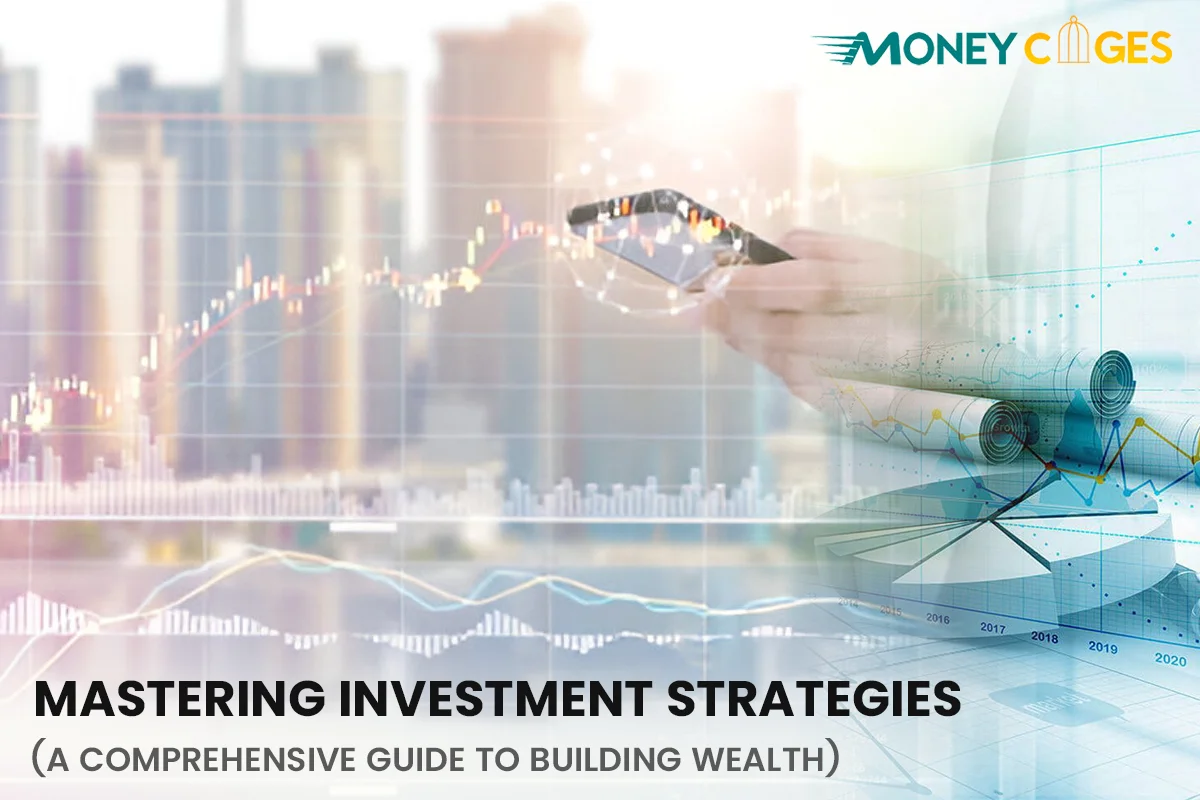Mastering Investment Strategies: A Comprehensive Guide to Building Wealth
However, in today’s financial global village, accumulating wealth as a financial asset is no longer only a result of saving, but more so depends on investing, given the type and nature of investment, level of risk that an individual is willing to take in order to achieve the financial objective. Given that new market trends, opportunities and economic changes occur on a daily basis it becomes very crucial to understand and practice good investment strategies.
No matter whether an investor is a developed one, who is thinking of refining the portfolio, or an investor who is newly entering the investment world, strategic planning is the key that opens the gateway to financial freedom and long term wealth accumulation.
Mastering the guidelines of strategic management on which it operates, lies not in the goals of gaining high revenues or following trends, but in forming a long term vision based on knowledge, reasonable planning and financial logic.
This termination guide includes the fundamental ideas of putting resources into as far as possible, proposed fiscal objectives and hazards the executive’s finances must confront in order to gain the optimum return. Matters like diversification, compounding and long-term investments are discussed to enable you to build a sustainable portfolio.
You will also discover how to harness current technologies such as robo-advisory and investment applications that minimize the decision-making process and bring the long-tail investing proposition.
The best is economic security and the freedom it provides that makes up the ultimate goal. Whether it is about having a sound retirement plan or saving for kids’ education or realizing personal goals, the right investment plan turns a dream into reality. To build wealth thoughtfully, all you have to do is get informed, make informed decisions, and let your wealth accumulate all on its own.
Let’s embark on this journey to mastering investment strategies, equipping you with the skills and insights needed to build wealth and achieve financial success in today’s dynamic world.
Table of Contents
The roadmap to wealth starts with the vision of how to get there.
Lacking clear objectives, the process may seem quite random, which means you can make choices that are not ideal for your financial situation. Managers need to set goals so that they have a clear plan of how their resources will achieve their overall desired state of affairs regarding the finances.
Before you choose an investment you should first define why you want to invest. Around what financial goals or aspirations are you planning to save: For a comfortable retirement, to buy a home or education for your children? All of these goals are associated with specific demands concerning the time horizon, risk/return characteristics.
For example, you might take a high-risk option for long-term investment such as investing for a retirement period while short term investments such as a down payment for a house, may force you to undertake low risk and highly accessible investment.
Another important consideration is of course the level of risk taking propensity that each investor possesses. You will find how you manage the market fluctuations reflected in the kind of assets you will seek. If you cannot stand even small pangs of uncertainty then investments in bonds or fixed deposits can be preferred despite giving lesser returns.
If you’re okay with taking somewhat higher risks for higher returns than Stocks or Equity Mutual funds investments could be more appropriate. Knowing your degree of risk assists you avoid stress and guarantees that you’ll stick to your strategy irrespective of changes within the market.
Second important factor is the timeline of your investment. It also alters things knowing how long you can leave your money invested or how long it is you intend to hold those stocks for. Investments for short-term objectives like for a vacation within the next three years will need to go into safer forms of investment like saving accounts or short term bonds.
Goals that are expected to be achieved in many years, for instance, financing for instance, retirement or future generations are usually more flexible to allow an investor to embrace higher risks, growth oriented security like equities or real estate.
The last thing you need to think about is your ability to fund your business. To avoid overstretching yourself, you total the money you earn and the money you spend, and check how much you are saving then consider the extra amount you can invest in the stocks.
Therefore, when subscribing to shares it is wise to set a predetermined amount of your monthly income to invest, say 15-20% of it. Finally, it helps to have an emergency fund ready first before going for the long-term investment to avoid cases of having to close your investment account to meet a financial emergency.
Therefore, knowing your needs, goals, risk tolerance levels, time and capacity of investment will enable the identification of the right instruments for investment. The above approach not only develops your confidence but also creates a foundation for a worthwhile and hassle free investment trip.
Diversification: Don’t Put All Your Eggs in One Basket
This is almost universally accepted as the ‘golden rule,’ of investing, also known as diversification, is one of the most basic tenets of investing. In layman terms, it is simply a process of investing in many different assets in an endeavor to minimize risk. The concept behind this is quite clear; there are times when various categories of assets, or industries, or sectors produce different results due to differences in economic cycles. Where you spread your types of investments, you can protect yourself in case there is a market segment that is struggling a lot to perform well.
The initial process in the diversification level involves making sure that you possess a diversified asset type. There are of course differences between equities or stocks, bonds and other instruments such as gold or real estate and how to invest in the market. For instance, although the stock is generally regarded as having high growth potential, it usually has high risk.
Equity on the other hand provides good stability and continual revenue streams though normally offers fewer returns compared to bonds. Other investments such as gold or real estate assets can be a safe asset when the stock market is volatile. The division of these assets can be beneficial in maintaining a good equilibrium in the return rates.
While it is indeed correct to diversify your investments across various classes of assets, it is also perhaps just as important to diversify within the asset classes. To be specific, if you are investing in the stock market make sure that you have stocks in different industries such as technology, healthcare, finance, and energy. Every sector has its peculiarities.
for example, technology stocks might benefit from the age of innovation while healthcare stocks would benefit from economic downturns. In this way, if one kind of the business is not very profitable, then the rest of them may contribute and make your profit acceptable.
Geographic diversification is another layer to that. Trading was the kind that offered patronage to economies with the different rates of growth and phases in the expansion of finances. For example, if the Indian market is stagnating, such investments may be sought in larger developed economies such as the US or in a relatively new economy such as the ASEAN. It can also decrease the relevance of local economic decline in the management of your portfolio at large considering globalization.
It means that although one cannot assure of making profits through diversification, one eliminates the possibility of suffering very huge losses. In this way, you protect your investment portfolio from excessive risk by having stakes all over the place; that is, taking equal quantities in various forms, kinds of commodities, sectors, or regions.
It can also make returns less volatile over the long term and provides the investor with comfort in the knowledge that no particular market event is going to wipe out all his/her financial planning. In other words, diversification is not only protection— it’s the process of getting the most out of the investment process.
The Power of Compounding
Compound interest, famously described by Albert Einstein as the eighth wonder of the world, holds immense power, especially for those starting investment for beginners. It showcases the incredible capability of taking small sums of money and turning them into a significant fortune over time.
This principle is especially relevant in stock market investment, where consistent returns can be reinvested into the initial principal, allowing the interest earned to progressively grow each year. This method of compounding has the potential to create substantial financial growth, making a noticeable difference in your financial life when applied over many years.

The beauty of compounding is in the recycling of earnings. When you invest, your capital works for you, and you are paid in one way or the other, by interest, dividend, or increase in price as cited in the article above. It is better not to withdraw such returns but to re-invest them, so that in the next cycle you will have command of even increased returns. It also leads to a situation where your investment base expands and generates larger increments of gains.
This perhaps explains why starting early is greatly credited for resulting in effective compounding. However modest the contributions are when one sets it up in twenties and thirties, it will be surprising how this corpus grows up to the time one retires.
For instance, assuming an investment of ₹5,000 per month starting at age 25 since the complete accumulation of ₹ 6,00,000 is way beyond what one would accumulate if one starts contributing ₹ 5,000 from age 35 to 60, despite the overall contribution time. It is probably one of the reasons why time is such a powerful driver for compounding, the returns are slow at first but the gains start to grow at a much faster rate.
And so is consistency. Systematic investing like SIP means you introduce consistency in the way you invest in the stock market and this regardless of what is prevailing in the market. Not only does this methodology allow capital to compound as well as the fluctuations dampened over time, but it also mitigates the impact of petty trends which swamp the bиг picture.
There will always be a greater potential for growth when you continue to reinvest the dividends and interest. For instance if you own shares that provide dividends, decision making to reinvest such dividends rather than selling boosts your stake. This, in the long run, results in even higher future dividends and capital appreciation, thus fueling the compounding effect.
This is the key message behind the concept of compounding: the longer you could let compounding work, the bigger the difference it makes. At first, [the growth] is gradual, but as the years go round, the returns compound, and the growth becomes even faster compared to the contribution made. Compounding is known as “money making money” and this is part of this phenomenon.
Embrace Risk Management
Contrary to what many people would like to believe, risk is always a companion of investment though this does not have to discourage investors. However, when it comes to risks, one is aware of the risks rather than focus on tactics and strategies employed that can add positive value to the business instead of working as a hindrance.
There will always be some form of risk associated with an investment, be it in the market, in the economy or the company. With the help of various known approaches to risky fuzzy estimation, you are able to protect your portfolio and make it comply with your financial objectives.
Stop-loss orders are practical in risk management and must form a part of the risk management strategies of any trader. These orders also give an opportunity for the selling of a security when its price has touched a fixed price and hence preserve one’s capital in volatile markets.
For instance if you bought a stock at ₹ ₹ 500 placing a stop loss at ₹ 450 you limit your loss. This strategy is well-suited for volatility characterised markets because it helps you avoid getting stuck in a losing position continuously without the need to monitor the market all day long.
Such specific decisions include the rejection of high-risk but unclear investment opportunities. It is a high-risk activity, and since the losses that companies involved in such opportunities are highly volatile. It applies to any given organization: a small company with which nobody has ever heard before, an unclear cryptocurrency with no definite benefits, or fabulous get-rich-quick schemes that have no evidence of their work – take your time, research the subject and try to estimate the potential risks and benefits before investing your money.
Maintenance of the portfolio is equally important from a risk management perspective and therefore, portfolio reviews meetings should also be held on a frequent basis. This is what happened in the market and the economy; new conditions have emerged, and the situation will not wait for you to act, it changes, and so does your personal life.
For instance, while saving for retirement, converting to low risk-gearing stocks such as fixed income securities guard your accumulated wealth. This is achieved similarly to managing risk by, for example, using a rebalance method that makes sure that no one portion of an investment portfolio is too large to mitigate against risk.
Finally, risk management is all about the right approach to what is in effect a risk-reward continuum. It means that by being forward thinking and consistent, one can avoid problems and have a good spread that ensures that no matter the volatility that is experienced, one’s financial goals and objectives are achieved in the long run.
Leverage Technology and Financial Tools

With the coming of technological advancement, especially in this century, investing has become more open, simpler and easier compared to the past. The development of advanced technologies has made it easier for investors, regardless of their level of experience, enhanced or not, to efficiently manage investments, make sensible decisions, and bring the required boosts to portfolios. In this way, with the help of these innovations, you get more personal control of your financial experience and receive the necessary results faster.
Robo-advisors for Automated Portfolio Management
The presence of robo-advisors is one of the largest developments in current investing. These AI enabled digital platforms offer you auto generated portfolio management based on your requirements and preferences such as financial objectives, risk profile, investment horizon etc. You complete some questions about your preferred types of investments and the system then builds a diverse portfolio for you and then automatically adjusts it according to the changing market environment.
It is most useful for novices who are not in a position to devote the necessary hours and energy to operate their investments efficiently. They are cheaper to acquire than traditional financial advisors, yet they remain strictly factual in their deliverables.
Mobile Apps for Real Time Update and Smooth Trading
Due to advances in modern technology, trading and portfolio management have become very easy via investment-based mobile applications. If you are a trader, all that is needed is your smartphone; for you can access real-time market data, analyze the performance of stocks, and place orders at the same time.
There’s also the added convenience of providing alerts, news, and detailed analytical data on the market situation. These platforms are suited for dynamic traders who will require frequent entries to the trade floor or those investors who make their analyses periodically. Social and entertainment apps also frequently make use of banking which encompasses easy transfers and investment.
Electronic Application Tools for Budgetary Calculations
When it comes to planning your investments and determining likely future earnings, financial calculators are all but essential. These calculators let you provide additional information such as initial investment amounts, expected rates of return and investment period in order to determine the prospect of your portfolio’s growth.
For example, using a compound interest calculator that brings out the ability of constant depositing to produce a significant increase in returns. Retirement calculators, SIP planners and loan EMI calculators help you to build a practical financial plan for achieving the goals, according to earning capacity.
This way, such investments are provided with a rational and efficient use of technologies that can make your investment process more effective and less time-consuming. Any individual whether a smart investor or a novice needs tools for making the investment process effective in the emerging complex financial environment.
Invest in Education
In my view, education is the foundation on which people should build their venture into investing. The more you know concerning the operations of the financial markets for investments and the general trends in the economy, then you will be in a better place to make correct decisions. This means adopting the process of learning to counter risks, optimize on returns to capture opportunities within the dynamic financial environment.

Join Webinars and Online Course
Thus, structured learning such as through the webinars or online courses provide relevant information on best investment options/concepts, technical analysis and portfolio management. These sources include platforms such as Coursera, Udemy together with financial institutions to offer lessons for novices as well as sophisticated investors.
This means clear and informative webinars from market analysts and experts help keep investors on the loop about the current trends, changing market landscape and new/updated investment approach.
Stick to Reliable Finance Sites
Subscribing to the best financial blog sites or listening to podcasts or engaging with the most credible financial analysis websites is helpful to learn the current market trends. Some of the widely acceptable dailies as Bloomberg, Economic Times or Moneycontrol present the Hub expert comments and a comprehensive analysis of global and domestic market conditions. Seasoned investors or episodes regarding economics are easy to follow as they do not require much attention when one is busy.
Seek Personalized Advice
In self-study, it is possible to develop an understanding of what has to be done and how it is done since a certified financial advisor guarantees personalized approaches. Consultants are good in explaining what investment is available, what problems one can expect there, and how to rebalance the investment.
They also keep up to date with the changes in the regulations and with the tax laws which enable you to make right investment decisions that are right for you and right from a legal perspective.
You need to read Investment Books and Case Studies
They can also reads some older works by other famous gurus, such as the Benjamin Graham’s ‘The Intelligent Investor’ or Peter Lynch’s ‘One Up on Wall Street’ – the books will never become stale as they explain the behaviour of the market and its tendencies. As demonstrated by examples of good and bad investment, numerous real-life examples of both good and bad investments are useful for a given approach.
Investing in such discussion forums
You get a wealth of information, exchange ideas and can learn a lot from experienced investors as per chats on Reddit’s r/investing, financial discussion groups, local meetings.
The next step is to make sure one updates themselves with the latest on changes to the financial regulations.
It is recommended you read through information posted on the various regulatory bodies such as SEBI so you can track changes that may be made in relation to your investments. To remain as compliant and informed as possible reduces risk and makes your portfolio the best it can be.
Over time the financial education will improve, and there will be less cautiousness in terms of financial decisions and therefore achieving the financial goal.
Think Long Term
One of the greatest advantages of an investor is a long-term view of the company’s development. Short-term movements in the market can be alarming but engaging in knee jerk reactions that lead to self sabotage of the best investment options plan can be dangerous for your goals.
Many people need to learn from successful businessmen that it is wiser to aim for long-term gains as opposed to the short-term profits, which come bundled with the dangers of the market.
It is a common practice that the best of the long term investment strategies require a lot of patience, more so during the bear runs. Cycles in the market are natural and the past has seen crucial periods of decline to be replaced by stages of regeneration.
Bailing out of investments during a bear run will crystallize losses that could have been reclaimed later on. This is why only leaving your money in the markets gives your portfolio the opportunity to ride the markets up as well as compounding.
Yet another thing that the long-term best investment options must guard against is market timing. Investing in financial markets and aiming to hit the highs, just as avoiding the lows is a challenging task for anyone, including professional investors, and very often an outcome of such an approach is failure to achieve any results. That is why consistency is a more important and disciplined approach like regular investments in the form of SIPs always pays off.
In SIPs you invest a fixed amount at a fixed joining interval which in turn allows you to do rupee cost averaging. It means you acquire more quantities at a cheaper price and small quantities at higher prices so you are able to reduce fluctuation in market price that affects the demand and supply curve over time.
It also means you can invest in the stock market for the long term, benefit from compounding which is the reinvestment of earnings to earn better returns. Longer your investments stay in the market, the higher is the effectiveness of compounding which helps to build good portions over a long time.
As a result, constant evaluation of the future and avoiding emotional decisions that will affect your investments prevent them from being a misalignment with financial goals. Regardless of whether the money you are accumulating is for retirement, generational wealth or any other long-term goals, planning means embracing the long-term approach necessary to see you through your wealth building journey successfully.
Tax Planning and Investments
Effective tax planning can significantly boost your returns. Utilize Types of investments that offer tax benefits, such as:

Equity Linked Savings Schemes (ELSS)
This is a Mutual funds investment that invests in equities therefore they yield returns which are linked to the market price but they also enjoy tax exemptions as provided in the IT act Section 80C. They mainly invest in equities and thereby have the advantage of giving high returns in the longer run. These funds have a lock in of three years, which makes it the best among all the Section 80C allocations.
Being a market fund, ELSS is suitable for investors who do not shy off from market fluctuations and who are actively inclined to save tax, besides making wealth. Moreover, even the LTCG taxes on ELSS up to ₹ 1,00,000 are nil making the investment in ELSS more tax-efficient than fixed maturity options.
PPF and NPS: Trusted Government Saving Schemes
PPF ‘Public Provident Fund’ is a Depository Saving Schemes that comes with fixed returns with no-risk and benefit of tax exemption. Both the amount invested in PPF is also allowed as a depreciation under Section 80C of the IT Act, while the interest earned on the amount is also free from tax. PPF is especially useful for long-run, low risk investing, since it is locked in for 15 years and produces moderate returns as well as offering tax-sheltered savings.
Another government introduced scheme is the National Pension System (NPS), which aims to offer pension after a certain age. Investments made in NPS come under the section 80C of IT act and there is a flat ₹ 50000 deduction allowed under section 80CCD(1B). Though further withdrawals at maturity are partly taxable during the savings phase and compounding, NPS are best investment options for a retirement plan.
Tax-Advantaged Accounts: An International Perspective
For the investors based in countries like the United States, the most favorable types of accounts for investing through are Roth IRA or 401(k). Amounts contributed are done so with money that has already been taxed, but the earnings are tax deferred, and distributions are tax-free.
In contrast, normal 401(k) plans enable pre-tax deductions that lessen curated income during the fiscal year that the contributions are made but the taxes are paid out when the funds are withdrawn in the retirement period. These accounts play a significant role in wealth creation over the long term and certainly in optimizing taxation.
Thus, when you choose tax saving investments as a part of your financial plan, it not only helps to increase your returns ratio, but also does not violate tax rules. And so, no matter whether you are considering ELSS, PPF, NPS, or other tax-saving and tax planning options at home and abroad, it pays to stay tax-effective and tax-smart.
Stay Disciplined
Punishment is the fundamentals of business riches making. If only buying and selling stocks can begin and end with fear and greed, then it will be best to constantly keep one’s head straight. The worst thing that an investor can do is to make irrational decisions based on emotions, which include elating during market upturns and panicking during market downturns and joining a bandwagon of investing in other fashionable frenzy instruments during market booms.
If you’re committed to investing you’ll be able to calmly stand your ground even when something is not known, follow your plan as long as it’s reasonable and maximize your potential income.
Fear and Greed
This is perhaps one of the most puzzling oddities when it comes to investment since the biggest challenge is maintaining an investment course during the highly volatile periods. While it is always hard to invest, one is more likely to yield to the voice of the heart during a decline of the market or be blinded by the desire for more profit during a steep rise.
Nevertheless, helping yourself to act in response to short term changes will slow down the achievement of your long term goals. The disciplined investor follows the sound strategies and does not herd with the crowd in following the trends and switching between investment decisions. If your financial profile is in harmony with your investment choices, the common-sense approach would be to do nothing knowing that markets have a history of rebounding and earning more in the long run.
Avoid the Herd Mentality
The second biggest mistake investors make is copying others, meaning acting based on other people’s behaviors. It is always important to understand that every single popular stock, sector or asset class does not mean it is right for you. Different strategies may suit other people’s needs, goals, and tolerance to risk and time frame different from yours.
Emotions make investors pursue herd effects they buy at higher prices or invest at wrong places normally leading to substantial losses when the market corrects itself. A disciplined approach means taking a decision on your own and following your research, your financial strategy, and your knowledge of what will be suitable to you only.
Regularly Review and Rebalance Your Portfolio
Discipline however does not mean giving your investments a free reign for them to run on their own. Specifically, one must ensure that the/certain asset allocation is current in a bid to meet their objectives or withstand the tolerated risks. Consequently, after some time different assets might increase in value and take up significant percentages of your overall portfolio.
For instance if equities shoot up through the roof their proportion in your portfolio will have risen beyond your ideal level putting you at risk. About rebalancing, it bears mentioning that it involves selling down assets that are invested more than they should be, and investing in assets that have been under-invested; rebalancing helps keep your portfolio on track as regards risk-reward.
Discipline in turn helps deter emotional biases, keep one’s objectives and objectives in mind, and develop a balanced fund. Therefore, disciplined investing, to a large extent, is not a process of risk elimination but of risk management with a high level of adherence to a sound plan.
Monitor and Adapt
Investing plants grow with both the maturing of the markets and changes in an individual’s life. Portfolio rebalancing keeps you on track with your goals as well as your risk profile, on the pathway to achieving your perfect financial picture.
Assess Performance: These are done on a regular basis in order to account for performance improvements, identify ‘problem-child’ assets, and take advantage of development chances. This retains the portfolio relevant and relevant to the unit’s objective.
Reallocate Assets: Market changes pose a threat in that they edge out promising stocks and bring in high risks or slow growth. Rebalancing brings diversification back, it provides stability to your portfolio to ensure it holds consistent to its goal.
Adjust Contributions: Substitute investments with neutral to income or financial requirements for changes in order to ensure sustainability. This flexibility preserves your long term plans, while addressing your need to balance current financial requirements.
It prepares you to prevent deterioration, maintain efficiency and relevance of your portfolio, and pursue your goals.
Conclusion
Mastering investment strategies is not a one-size-fits-all journey; it requires a personalized approach, continuous learning, and disciplined execution. By understanding your goals, managing risks, and leveraging diversification, you can build a robust portfolio that stands the test of time.
Remember, wealth-building is a marathon, not a sprint. Start small, stay consistent, and watch your investments grow into a solid financial foundation for the future.



